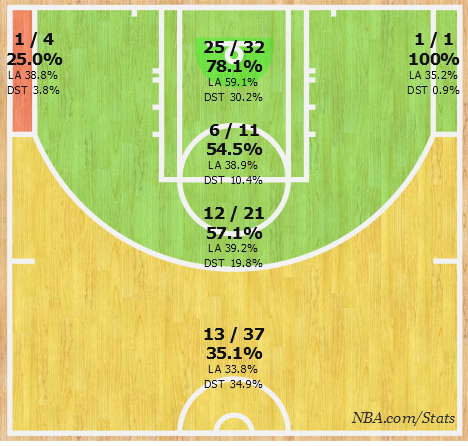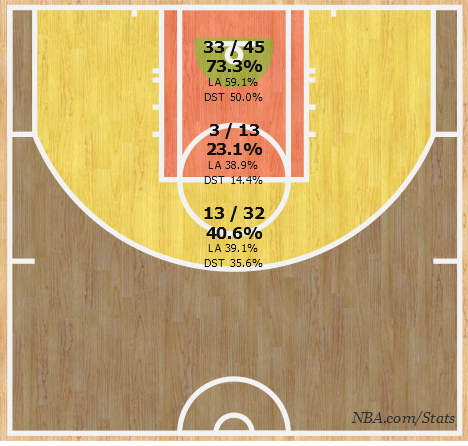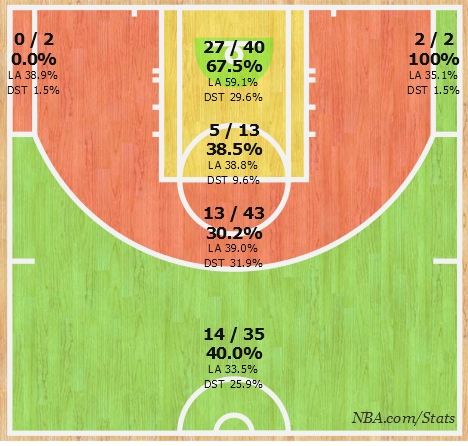Jeremy Lamb, Dwight Powell, Will Barton, and Zach LaVine have been playing at or above expectations early in the season. I decided to analyze how they've scored their points in an effort to parse sustainability from fraudulent behavior.
Jeremy Lamb, G, CHA
| Points Per 100 Possessions | FG% | 3Pt% | FT% | TS% | Usage Rate | |
| 2015-16 | 26.8 | 54.7 | 35.7 | 63.6 | 62.3 | 20.9 |
| Thunder Career | 22.3 | 42.4 | 34.8 | 85.7 | 52.3 | 20.5 |
Lamb's early season success has less to do with his long-range shooting and based more on his improved shot selection. He's shooting 67.2 percent on two-point field goals (league-leading among qualifiers), 77 percent inside of eight feet, and attempting a quarter of his shots in the restricted area. His free-throw percent is out of whack because he's only 7-of-11 through 11 games. Even with the insane amount of attempts inside the paint, his free-throw rate is incredibly low and congruent with his career average. Of all the players scoring at least 5.0 points in the paint, Lamb draws the fewest fouls per game (1.1).
Lamb's 6'11" wingspan allows him to get shots over opposing reserve frontlines. He's attempted an equal number of shots in the restricted area (32) as other non-three-point shots. The long arms are key in his ability to avoid getting blocked, which has occurred just four times all season. Of all 88 players averaging at least 5.6 points in the paint, only Andrew Bogut, T.J. Warren, Robin Lopez, Omri Casspi, John Wall, and Jimmy Butler get their shot blocked less often. And Lamb's not compiling gimme layups; His transition buckets are minimal, and Lamb is genuinely driving through traffic and finishing with either hand while avoiding contact.
Lamb has played most of his minutes with Marvin Williams, Jeremy Lin, and Spencer Hawes. The Hornets are running plays for Lamb where Lin reverses the ball to Hawes on the weak side and Hawes finds an open Lamb curling off a double screen. Hawes and Lamb also work the dribble-handoff, a play that provides Lamb enough daylight because Hawes' defender clings to the three-point threat. Lamb does a great job of catching the ball high and shooting in one motion. When he's run off the three-point line, he's able to take one dribble inside the arc and rise in rhythm or slither to the rim given his length.
[caption id="attachment_10210" align="alignnone" width="468"] Jeremy Lamb's Shot Chart[/caption]
Jeremy Lamb's Shot Chart[/caption]
Dwight Powell, F, DAL
The Mavericks signed roughly seven centers this offseason after DeAndre Jordan stayed with the Clippers. Most of the castoffs were waived or injured, leaving Powell as the lone reserve center facsimile. He was a throw-in in the Rajon Rondo deal last season, and he demolished D-League competition. A shaky summer tour with Team Canada and an elbow injury in preseason halted expectations, but like many before him, playing alongside Dirk Nowitzki has done wonders for Powell's development.
Powell operates near the rim, attempting half his shots in the restricted area, and he's shooting 62 percent inside of eight feet. He's not a low-post threat; rather, Powell is the roll man in pick-and-rolls, and he camps under the basket if he doesn't receive the immediate pass. Teammates have set him up for all but seven of his made baskets, spearheaded by J.J. Barea, who's responsible for 19 of Powell's 49 buckets. Powell's unassisted baskets consist mainly of putback dunks.
Powell is Zaza Pachulia's primary backup. They've averaged about 6.0 minutes per game on the court together, but Powell's shooting efficiency drops from 59 percent without Pachulia on the court to 42 percent when Powell subs for Nowitzki instead of Pachulia. The offensive spacing gets disrupted with a frontcourt of Powell and Pachulia, forcing Powell further from the basket as a pick-and-pop player. 16 of his 24 shots (67 percent) alongside Pachulia come from the midrange zone, of which he's converted four. This becomes an important distinction if JaVale McGee (leg) ever returns from injury. Another backup bigman would likely disrupt Powell's playing time with Nowitzki.
Even though Powell is shooting 62 percent from the free-throw line and hasn't attempted a three-pointer, he made 11-of-28 three-pointers (38 percent) and 51-of-72 free-throws (71 percent) in 23 D-League games last season.
[caption id="attachment_10182" align="aligncenter" width="468"] Dwight Powell's Shot Chart[/caption]
Dwight Powell's Shot Chart[/caption]
Will Barton, G, DEN
| Points Per 100 Possessions | FG% | 3Pt% | FT% | TS% | Usage Rate | |
| 2015-16 | 26.2 | 48.1 | 44.4 | 87.9 | 58.9 | 20.6 |
| Career | 20.3 | 41.7 | 26.5 | 79.9 | 49.1 | 20.5 |
Barton was acquired by the Nuggets at last season's trade deadline. Over the final two months, Barton was ranked 109 in eight-category fantasy leagues in 24.4 minutes per game. His current per possession numbers rival those of his 28-game stint with the Nuggets last year, sans his inflated 44 percent accuracy from downtown. Per stats.nba.com, all 36 of Barton's three-point attempts have been classified as open or wide open, and all of them have been assisted. Based on the video, roughly a third of those attempts were contested.
Barton comes off the bench behind Gary Harris, but by the time he's checked in, the Nuggets are in the hole. The Nuggets are the worst first-half team based on point differential, sporting a negative 7.0 plus/minus. In their six losses, the Nuggets have lost by an average of 17.2 points, the second-worst margin in the league. I've maintained that Barton benefits from lopsided basketball games. The early season blowouts pave the way for Barton to exploit lax second-half defenses. He's scored 44 percent of his points with the scoring margin greater than 10 points, and he's 15th in fourth quarter scoring. The table below illustrates Bartons' performance throughout a game.
| Quarter | Points per quarter | Field Goal Percentage | Minutes |
| 1st quarter | 0.8 | 21.1% | 3.5 |
| 2nd quarter | 4.3 | 51.4% | 7.9 |
| 3rd quarter | 3.4 | 65.2% | 6.0 |
| 4th quarter | 6.0 | 48.0% | 9.8 |
The third-year guard isn't creating for himself as much as in previous seasons. It helps when your two facilitators are Emmanuel Mudiay and Jameer Nelson, even though Barton has only converted 36 percent of his shots after receiving a pass from Nelson. Two-thirds of Barton's baskets have been assisted, and he's pouring in 4.5 points off turnovers, 6th most in just 26.7 minutes a game. When Barton dribbles the ball at least once, he shoots 41 percent, a 17-percent drop-off from when he doesn't dribble.
The evidence of his garbage-time stat padding is damning. However, Barton is shooting 56 percent from the field in wins and 43 percent in losses. He also plays four fewer minutes in wins. At some point, a trend becomes the norm, and with the Nuggets struggling to stay competitive, Barton is adding value beyond points.
[caption id="attachment_10193" align="aligncenter" width="468"] Will Barton's Shot Chart[/caption]
Will Barton's Shot Chart[/caption]
Zach LaVine, G, MIN
| PTS | FG% | 3Pt % | FT% | TS% | Usage Rate | |
| 2015-16 | 13.9 | 45.2 | 41 | 87.9 | 55.8 | 27.3 |
| 2014-15 | 10.1 | 42.2 | 34.1 | 84.2 | 51.5 | 22.0 |
LaVine worked with shooting coach and former NBA player Mike Penberthy in the offseason. Penberthy has worked with Ricky Rubio, Paul George, and Reggie Jackson in the past. Tangible improvements in shooting percentages can take a few years to come to fruition, and they require repetition to before muscle memory adheres.
LaVine is still a poor shooter off the bounce, but he possesses the physical tools to grow into a solid shooting guard. On the macro, 74 percent of his baskets are unassisted (up 18 percent), 43 percent of his three-pointers are assisted, and 23 percent of points have been scored on fast breaks (down five percent). You may not be aware, but LaVine leads the Timberwolves in three-point shooting.
The jump shot requires refinement, but he's fine in catch-and-shoot situations. His mechanics are actually quite smooth, but he needs to stop fading away on his mid-range jumpers or scrap them completely. There are too many possessions where he doesn't pass the ball, receives a pick, and pulls up from 17 feet with more than 12 seconds left on the shot clock. Conversely, about a quarter of the time, LaVine bails out the offense with a jumper in the final moments of a possession.
His athleticism allows him to explode to the rim, pick up cheap fastbreak points, and limit opponents' blocked shots - he's only been blocked seven times this season. He does shy away from contact and could use fine-tuning on his reverse layups, but this is the second straight season LaVine finishes above league average in the restricted area. It helps when Nemanja Bjelica can space the floor and facilitate. Bjelica has played the most minutes with LaVine this season, and LaVine has received most of his passes from Bjelica, roughly 37 percent. Bjelica may be the most passive non-guard in the league.
As the primary backup point guard, LaVine must improve his playmaking and recognition. There are too many possessions where he doesn't even make a pass. In a league where two-thirds of the starting points guards are above replacement level, many of the backups, outside of Isaiah Thomas and Darren Collison, don't negate LaVine's defensive deficiencies and can't deter his streaks to the basket. There probably aren't many backup shooting guards that can hinder LaVine, but for now, he's developing as a point guard (Ricky Rubio and LaVine have played 28 minutes together this season).
[caption id="attachment_10168" align="aligncenter" width="468"] Zach LaVine Shot Chart[/caption]
Zach LaVine Shot Chart[/caption]



